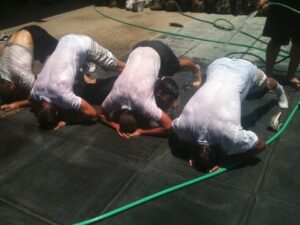“I commit to feeling my feelings all the way through to completion. They come, and I locate them in my body then move, breathe, and vocalize them so they release all the way through.”
Commitment 3: Jim Dethmer, Diana Chapman, and Kaley Warner Klemp
At the beginning of last year (2021), I started a new job. I was hired as the Director of Human Performance and Leadership Development for an insurance company. The job lasted a total of two months. During that time, I felt a LOT of feelings, most of which were unpleasant. Prior to leaving, I frequently entertained the thought of leaving as well as looked for new opportunities where I could contribute and be of value.
It was very challenging to feel such intense emotions, many of which included feeling lonely, scared, disappointed, upset, dissatisfied, irritated, indignant, infuriated, disgusted, embittered, hostile, confused, and unsettled. In my judgment, the main reason for this was that the organization was a lot less healthy than I had been led to believe. The organization had only recently come out of its “start up” growth phase and there were a lot of fear based habits of behavior, e.g., micro-managing, manipulating for control, gossiping, reactionary decision making, and a lack of clarity/commitment/alignment on values and goals.
Nonetheless, there were people there that I liked and got along with and opportunities for me to be helpful, valuable, and in alignment with my WHY (equip people to become extraordinary lifelong learners about themselves, others, and their pursuits, so that they are more capable of living interesting, fulfilling, and meaningful lives).
Additionally, even though it was literally difficult to stomach at times, I learned a lot, not the least of which was observing organizational human dynamics in real time amongst many different people with a variety of different titles and responsibilities.
During this time, I started thinking a lot more about what Seth Godin has written pertaining to the concept of emotional labor: The task of doing important work, even when it isn’t easy… doing something difficult, taking a risk, and extending yourself like when confronting fear (whether that’s in making connections, speaking, inventing, selling, or dealing with difficult situations) in order to make a difference.
In The 15 Commitments of Conscious Leadership, the authors define emotion as ENERGY in motion (e-motion). Energy and labor certainly go hand in hand. Emotional labor, then, is welcoming, accepting, and RELEASING the challenging sensations that flow through us (as a part of our body budgeting) in service of the change we seek to make.
“Just like companies that have a financial office for making sure that their overall budget is balanced, your brain manages the budget for all the accounts in your body”
Lisa Feldman Barrett
If our experience of emotions are, in fact, made based on how we use words to describe what we are feeling, then it is up to us to actively release our emotions more rapidly, so our brains do not predict the need to recycle the perception of certain emotions when experiencing seemingly similar situations from our past.
Emotions are NOT objective facts of reality. They are interoceptive interpretations.
Making sense of these interpretations adaptively is laborious. It requires expending energy to overcome our tendency to judge and over identify with our emotions. We can do this by seeking to understand our emotions based on what happened in a specific situation, as opposed to generalizing the prevalence and impact of what we are feeling to other unrelated situations.
The way in which this can be practiced involves presently attending to our bodily sensations non-judgmentally–feeling them as billions of bits of bodily activity–and practicing the commitment to be curious with wonder based questions.
For example,
- What about these feelings are unsettling?
- Where exactly in my body do I feel these feelings?
- If I was in a preferable context and feeling these feelings, how might I interpret them differently?
- What do these feelings remind me of?
- What if these feelings are not intended to relay anything of importance?
- Can I allow myself to feel the feelings FULLY for 90 seconds and then be presently attentive toward other stimuli?
- Why do I feel the need to recycle my attention on these feelings?
- What might it feel like to feel without concluding WHY I am feeling this way?




